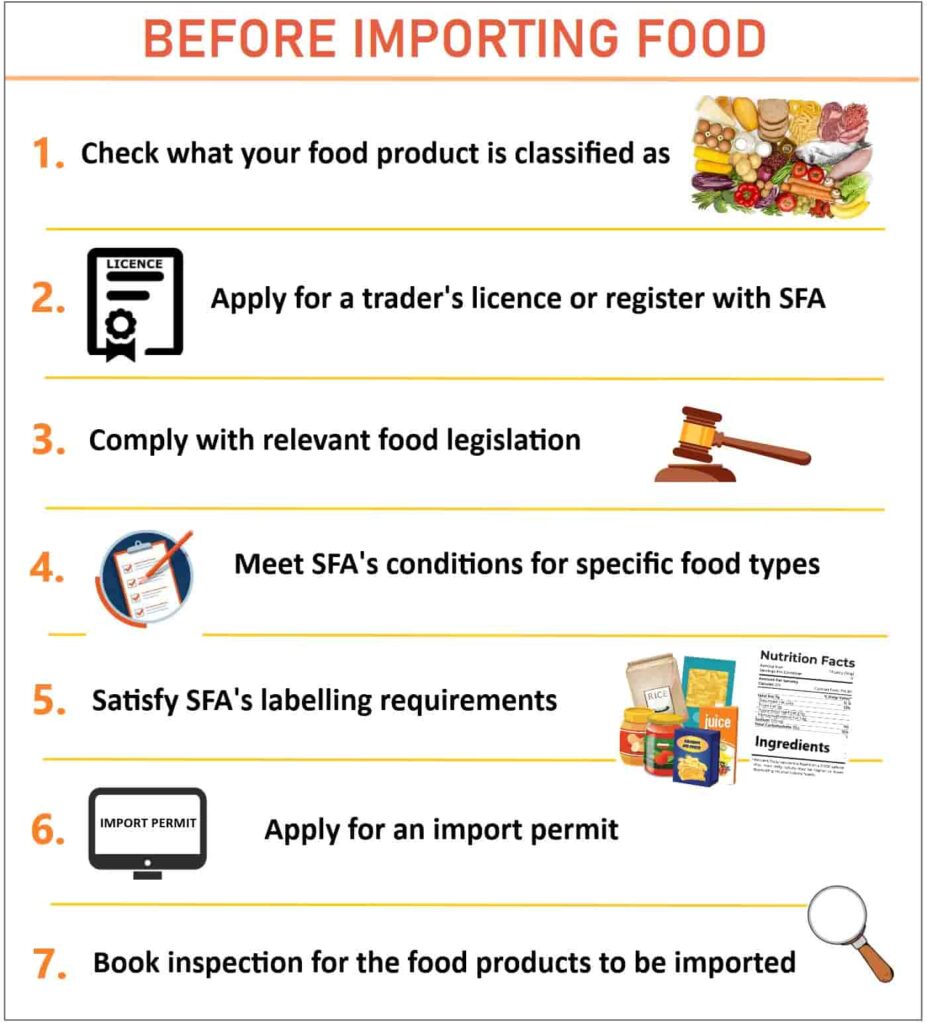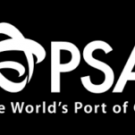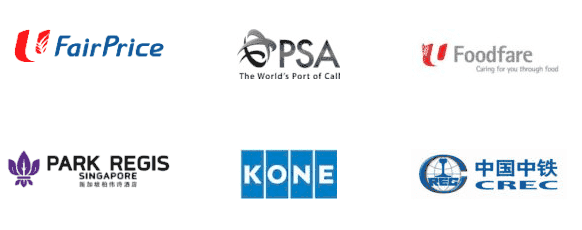Importing Food Products into Singapore
Singapore’s unique position as a land-scarce nation with minimal agricultural output necessitates the importation of approximately 90% of its total food consumption. This demand, fueled by both a robust local population and a thriving tourism industry, makes Singapore a focal point for food imports in Southeast Asia. This comprehensive guide aims to streamline the complexity surrounding the food import process, ensuring your venture into Singapore’s market is both successful and compliant.
Singapore’s Food Market: An Overview
Singapore stands as Southeast Asia’s most advanced food retail market. The traditional wet markets still play a pivotal role in the daily lives of Singaporeans, dominating sales in essential items like vegetables, seafood, and meats. However, as the nation’s economy grows and consumer preferences evolve, supermarkets and hypermarkets are rapidly gaining ground, offering diverse and international food products to meet the sophisticated tastes of Singapore’s populace.
The Gateway to Southeast Asia’s Food Service Industry
Singapore isn’t just a market; it’s a hub. With its strategic geographical location, it serves as a central point for the food service industry, catering to hotels, restaurants, airlines, and more. This positions Singapore as an invaluable node for the trade of fine gourmet food products and supplies, providing a gateway for businesses looking to tap into the broader Southeast Asian market.
Importing Food Products into Singapore: Regulatory Framework
Food Importers are required to guarantee that all food products brought into Singapore for commercial sale are safe for consumption and adhere to the nation’s food safety standards and regulations. Only those traders who have obtained a license or registration from the Singapore Food Agency (SFA) are permitted to import food for commercial purposes. Imported food products are subject to potential inspections and sampling to ensure they meet food safety criteria. Any food found to be unsafe will be prohibited from sale.
Step-by-Step Guide to Importing Food into Singapore

Step 1: Determine Your Food Product’s Classification
The Singapore Food Agency (SFA) categorizes food and food products into various groups, each subject to specific conditions and requirements. To ascertain your product’s classification, refer to the General Classification of Food & Food Products.
Before checking the general classification of food products, traders and manufacturers of food-health products need to determine which competent authority regulates their products. Food-health products could fall under the regulation of either:
- Singapore Food Agency (SFA), or
- Health Sciences Authority (HSA).
The import and sale of food and supplements of food nature are governed by the Sale of Food Act and the Food Regulations under SFA. Importers must ensure that their products comply with SFA’s regulations and labelling requirements.
Step 2: Obtain a Trader’s License or Registration
Before importing food into Singapore, obtaining a trader’s license or registering with the SFA is mandatory. To obtain licenses and registration with the Singapore Food Agency (SFA), traders must adhere to the following prerequisites:
2.1. Company Registration with ACRA
Before initiating any business activities in Singapore, it’s mandatory to register a trading company with the Accounting and Corporate Regulatory Authority (ACRA), which will issue a Unique Entity Number (UEN) to your company.
2.2. UEN Registration and Activation with Singapore Customs
For businesses planning to import, transship, or export food products, registering and activating the UEN with Singapore Customs is essential.
2.3. Setting Up and Managing a GIRO Account
Singapore Food Traders are required to establish and maintain a GIRO account with SFA for all related payment transactions, including fees and permits.
Should there be a need to modify your GIRO account information with SFA, a new GIRO application form must be submitted. It’s important to keep the existing GIRO account active until the new one is officially approved to avoid potential suspension of your license due to the absence of an active GIRO account with SFA.

Step 3: Adhere to Food Legislation
It’s crucial that all food imports align with SFA-governed legislation. Below is a quick overview of food types and their corresponding legislations:
- Meat and Fish: Wholesome Meat and Fish Act, Sale of Food Act
- Fresh Fruits and Vegetables: Control of Plants Act, Sale of Food Act
- Fresh and Processed Eggs: Animal and Birds Act, Sale of Food Act
- Processed Food and Food Appliances: Sale of Food Act
Step 4: Comply with SFA’s Food-Specific Conditions
Singapore food importers must ensure their food products meet SFA’s specified conditions, which vary depending on the food type, source country, and other factors. Accreditation is required for importing meat, eggs, and their products.
- Meat & Meat Products
- Eggs & Egg Products
- Fish & Fish Products
- Fresh Fruits & Vegetables
- Processed Food & Food Appliances
- Novel Food
- Genetically Modified Crops
Ensure all food additives and ingredients are approved by the SFA.
Step 5: Fulfill Labeling Requirements
Processed food products destined for import into Singapore must comply with the Sale of Food Act, which outlines specific regulations concerning:
- Packaging: Ensuring the integrity and safety of food packaging.
- Expiration Dates: Clear labeling of sale by and expiration dates to guarantee product freshness.
- Labeling Requirements: Detailed labeling to inform consumers about the product.
- Food Constituents: Adhering to stipulated levels of certain ingredients permissible in each food category.
All processed food imports undergo rigorous inspections. Based on trend analyses and classifications, some products are deemed high risk and therefore require thorough pre-market evaluations, including laboratory testing and health certification, to confirm their safety. The health certificates, provided by the originating country’s authorities, must detail:
- Product Description and Packaging: Including any brand or trademark information.
- Quantity: Specified by weight.
- Processing Establishment: Name and address of the facility where the food was processed.
- Consignor and Consignee Information: Names and addresses of the shipper and receiver.

Step 6: Secure an Import Permit
After meeting all pre-import criteria, apply for an import permit via TradeNet. SFA mandates an import permit for all food and food product imports, regardless of transportation method.
6.1: Get Ready
Gather the following information:
- Your license or registration number
- Product or HS codes
- Establishment code
6.2: Apply for a Permit
Use TradeNet to apply for an import permit and receive a Unique Reference Number.
Submit your application on TradeNet by:
- 5:30 pm (Mon-Thurs)
- 5:00 pm (Fridays)
Applications submitted on weekends or public holidays are processed the next business day. To avoid delays, ensure you have all required documents before applying on TradeNet.
6.3: Submit Additional Documents
If needed, like laboratory reports or health certificates for specific food products, attach them online via TradeNet.
6.4: Receive Your Permit
Once approved, you’ll get a Cargo Clearance Permit (CCP), which is also your SFA import permit. Read any conditional approval messages in your CCP carefully and follow the requirements closely. Not following these conditions can lead to penalties.
6.5: Print Your CCP
Print the CCP for use at border checkpoints, inspections, etc.
Step 7: Schedule an Inspection
Upon arrival, imported food is subject to routine SFA safety inspections and may undergo laboratory testing to verify safety regulation compliance.
- Booking an Inspection: Make an online booking for inspection of meat products, processed eggs, seafood, fresh produce, processed foods, and appliances through SFA’s Inspection & Laboratory e-Services.
- Pre-Inspection Preparation: Have the Cargo Clearance Permit and relevant documents ready, along with the food consignment. For frozen raw meat, one carton should be surface-thawed before inspection.
Inspection Failure: Food failing to meet SFA standards, or contaminated with radioactive materials, cannot be sold or distributed within Singapore. Such consignments must be returned or re-exported. Non-compliance may lead to the suspension of the importer or the source/exporter from the Singapore market.
This streamlined guide is designed to help navigate the process of importing food products into Singapore efficiently, ensuring compliance with Singapore’s stringent food safety regulations.
Conclusion: Mastering Food Imports into Singapore
Singapore’s food import market is both challenging and rewarding, offering unparalleled opportunities for businesses that can navigate its regulatory environment and meet its diverse culinary demands. By focusing on quality, compliance, and market research, importers can successfully introduce their products to Singapore’s sophisticated consumers and leverage the city-state’s strategic position in the Southeast Asian food trade.
Company Registration
For a smoother business registration and food trader licensee application process, consider partnering with a Singapore accounting firm such as AG Singapore. As a comprehensive mid-tier accounting firm, we offer a range of services tailored for SMEs, including company incorporation, accounting, tax, audit services, and additional compliance support.
Why outsource to AG Singapore?
- OCBC Prestige Partner in Singapore: Recognized for outstanding corporate services.
- 5-Star Google Reviews: Achieved a top rating based on feedback from over 184 clients.
- Exceptional Track Record: Successfully incorporated over 200+ Private Limited (Pte Ltd) companies within a year.














